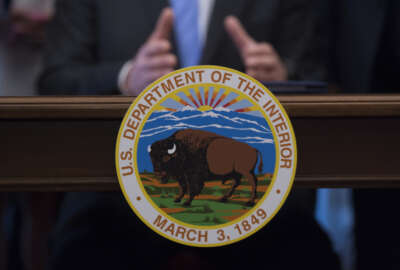
Interior offers a preview of its reorganization plan
Interior Secretary Ryan Zinke said he intends to divide the country 13 broad regions where a senior executive would manage and lead each area with joint input a...
As agencies are expected to unveil detailed versions of their reorganization and reform plans in the president’s 2019 budget proposal, due next month, the Interior Department is giving a preview.
Secretary Ryan Zinke outlined his vision for the department to Interior senior executives last week at a “Planning for the Next 100 Years Summit” in Washington Jan. 10-11.
The general plan is to organize and manage the department based on 13 broad regions across the country. Interior “regional leaders” would head up each of the 13 areas and coordinate collaboration between the department’s bureaus to make “key management decisions,” Zinke said.
“We’re looking at reshaping our current bureau-based regional system of management and moving to a system based on ecosystems, watersheds and science, rather than the current state or regional boundaries,” he said in a video message to Interior employees. “This concept will allow Interior and the participating agencies to address concerns using a system-level approach to better manage important resources such as watersheds, trail systems, infrastructure requirements, recreational access and wildlife corridors.”
Specifically, senior executives who attended the summit were asked to consider what changes the department would need to make to begin an “expeditious, smooth transition to a common regional structure,” according to an agenda from last week’s event.
Zinke recognized the importance of maintaining traditions among Interior’s bureaus and subcomponents but said these organizations have an opportunity to work collectively on specific missions, such as permitting, recreation and environmental studies.
“How we operate and work together within an ecosystem will be more joint and collaborative in [our] approach,” he said. “To make it work, it’ll also require giving more flexibility, resources and decision-making authority to front-line superintendents and managers so that right action can be quickly made without excessive paperwork and burdensome administrative requirements. It will require our scientists to reside in the field doing research and not in the office writing grant proposals asking permission to do research. Our focus will be better field management by delivering the front line the assets they need to make better decisions.”
Not every office within the department will see such sweeping changes, and budget, personnel, legal and other administrative functions “will see little if any change at all,” Zinke said.
Zinke said he will initiate and lead the department’s reorganization, and Interior employees will later implement the plan from the field.
“Now is the time to be transformative, since 16 percent of Interior personnel today is [of] retirement age,” he said. “In five years, nearly 40 percent of Interior will be. As our Interior professionals retire, we owe it to our new and existing team members to provide transparent career progression, greater promotion and educational opportunities and the highest level of job satisfaction.”
The department’s senior executives have previously said they’ve felt “left in the dark” about Interior’s reorganization plans. SES members said in August that they’d had “absolutely no involvement whatsoever” in crafting the agency’s plans. Some senior executives at Interior’s Denver regional office heard about a few aspects of the reorganization plan at a meeting with top leadership over the summer.
Senior executives who attended the summit were asked to consider the advantages and disadvantages of having an Interior regional leader position coordinate field activities for the department’s leadership and staff, according to an agenda from last week’s event.
In addition, Interior senior executive service members considered what cities within their own region of the country could best serve as one of the 13 regional hubs, the agenda said. Summit attendees were asked to “pick cities with a reasonable cost of living” where they “might enjoy living.”
Senior executives, think tanks and policy organizations have acknowledged that such changes would likely require help from Congress.
Last December, the House Natural Resources Committee heard from several organizations, including the Western Energy Alliance, Coalition to Protect America’s National Parks and the Heritage Foundation, which weighed in on some of the preliminary details of Interior’s reorganization plan.
Republicans on the committee advocated for Interior reorganization and relocation, citing locality payments for federal employees in the Washington metropolitan area as one area where the department could save by moving more of its staff members to other regions.
“To complement the delegation of authority, DOI should consider relocating and/or consolidating the headquarters of some of its bureaus in the western states where much of its work is conducted,” the majority committee’s staff report on the topic reads. “Relocating DOI bureaus away from Washington, D.C., to a western state will not only improve the effectiveness and quality of service but will also bring long term savings to the American taxpayer. … While there will be an initial cost to any relocation, moving to areas with lowers costs of living will ultimately save the taxpayer money in the long-run.”
However, a few of the organizations that testified last month expressed some concern with the department’s preliminary plans. The Coalition to Protect America’s National Parks, for example, cited previous reorganizations at the National Park Service and argued that such moves created and ultimately led to current dysfunction at the agency.
Copyright © 2024 Federal News Network. All rights reserved. This website is not intended for users located within the European Economic Area.
Nicole Ogrysko is a reporter for Federal News Network focusing on the federal workforce and federal pay and benefits.
Follow @nogryskoWFED





